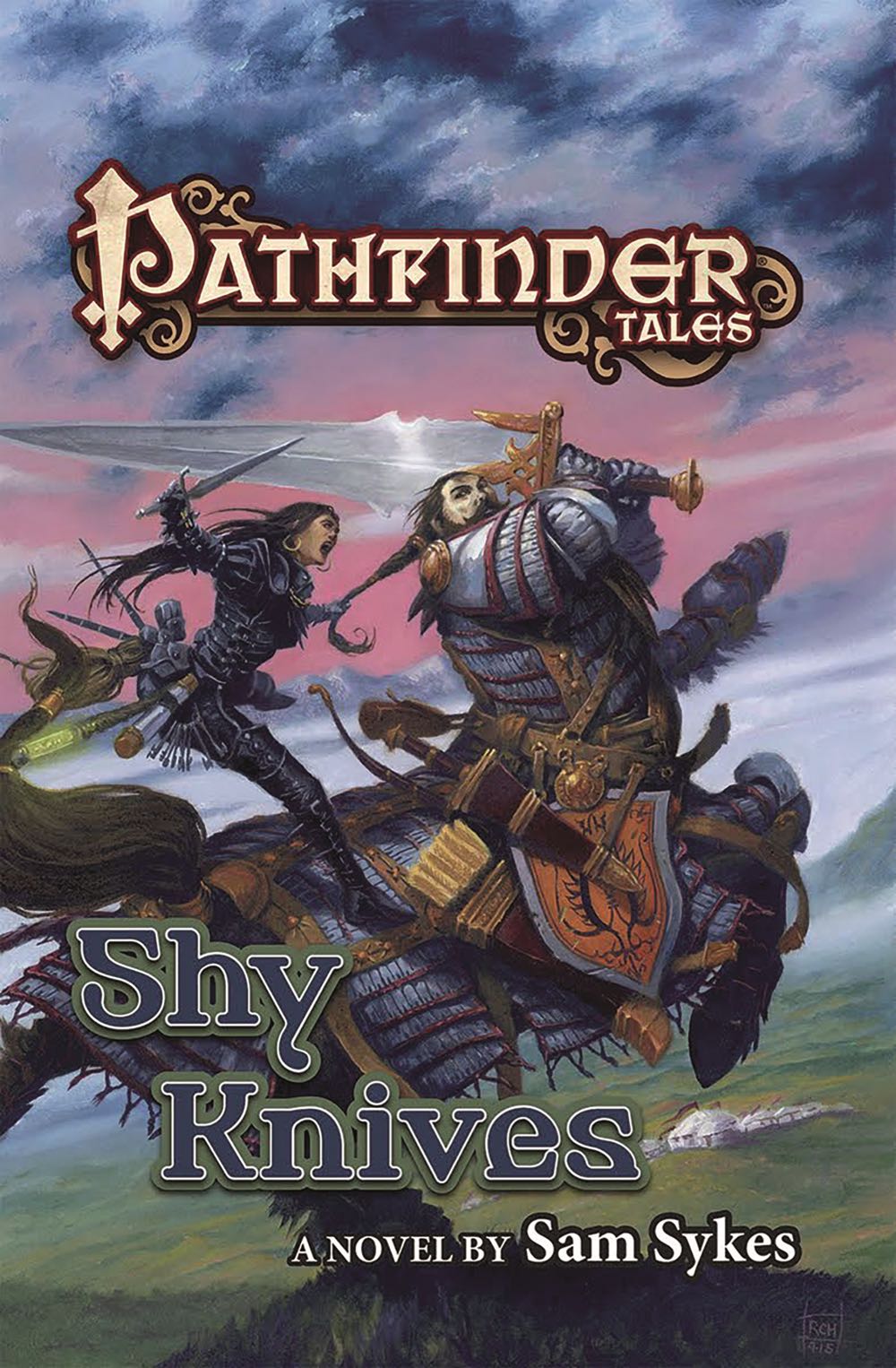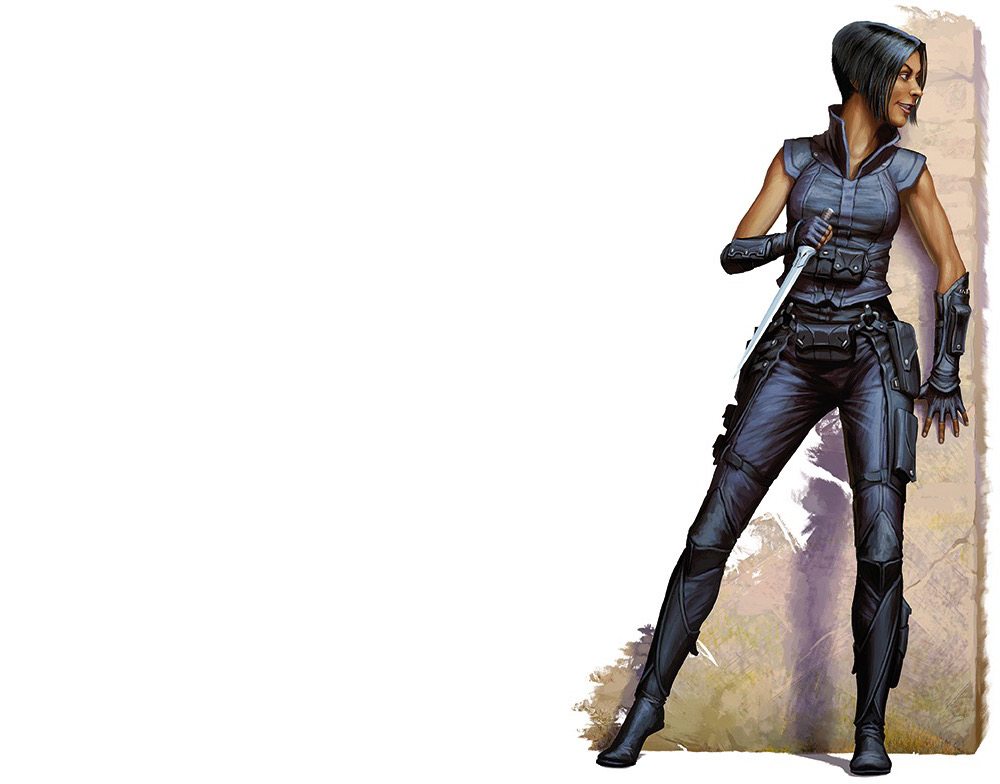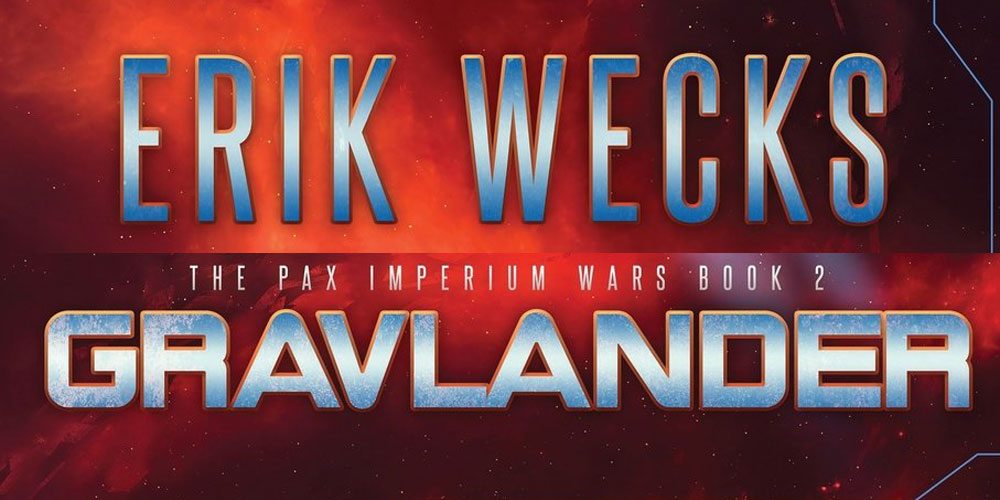
Shy Knives, Same Sykes exciting new Pathfinder Tales novel, has been released into the wild and is available right now. Pathfinder Tales are novels based in Paizo’s Pathfinder Roleplaying Game universe. As a stand-alone novel, requiring no prior knowledge of the game or Pathfinder’s world of Golarion, Shy Knives is an excellent introduction to both.
Shaia “Shy” Ratani is an entertaining depiction of a morally-ambiguous rogue tasked with solving a nobleman’s murder. Like any good adventure, Shy quickly gets involved in something much larger.
GeekDad was fortunate enough to get the opportunity to ask author Sam Sykes a few questions.
GeekDad: You succinctly described your Pathfinder Tales novel Shy Knives as, “surly detective solves mystery with demons, centaurs and MURDER.” As if that’s not enough, can you tell us a little more about Shy Knives? What are we in for?
Sam Sykes: Shy Knives is a detective story. A noir, if noirs had more centaurs and talking corpses. And our detective is a mostly-selfish, occasionally-decent, frequently-opportunistic woman named Shy. In the city of Yanmass, a last holdout for the ultra-wealthy waiting for their country to collapse, a noblewoman’s betrothed has been murdered. Shy has been persuaded, via the promise of an immense amount of platinum, to find out who did it.
Encroaching centaur clans set on carving their own nation out of a dying empire are bad enough. But before long, Shy finds herself embroiled in the machinations of thief guilds, political ambitions and demonic eugenics.
I mean, if I can’t tempt you to read it with that description, then I give the hell up. You should go read Nicolas Sparks or something. I hear his new one is about a sexy magician or something?
GD: Novel writing involves quite a bit of research. In your blog you discuss how Paizo provided some research material such as Inner Sea World Guide, and you picked up Visions of War, a book of the awe-inspiring Pathfinder art by Wayne Reynolds. In addition to this being a new setting for you, Shy Knives has thieving, knife wielding, investigations; what’s the most interesting thing you learned while writing the novel?
SS: The research portion of a tie-in fiction mostly involved me picking things out of the Inner Sea World Guide and asking James Sutter (my editor): “Can I do this?” And then he’d say: “No.” And I’d say: “Well, why the hell not.” And then he’d say: “Because that is a crime, Sam.” And I’d be all: “We all must suffer for our art, James.”
No, but seriously, I can’t nail down one thing I learned because I set out to play, not to learn. Pathfinder was, for me, a big playground with all this equipment already built that I could mess around with. I suppose, in doing so, I learned a little bit about politics, a little bit about trade, and maybe something about myself. But mostly, I learned that I can’t kill a demon with electricity.
GD: I see you’ve played in the yearly Author DnD game at ConFusion, but it looks as if you have not had much opportunity to actually play fantasy role-playing games such as Pathfinder. How are you able to so accurately portray the fantasy campaign feel in your books?
SS: I have no idea.
That sounds flippant, I know, but, I mean…what’s an “accurate” campaign feel?
Everyone’s game is different. Malazan Book of the Fallen by Steven Erikson was based off a GURPS game he played and it has this massive, sprawling empire of a story that goes across vast amounts of time and space. My work is much more intimate and focused and full of irritable, angry people.
I wanted to write about adventurers. And my opinion of adventurers, based off what few RPGs I could play on tabletop and the countless ones I played on my computer (Icewind Dale represent), was that they were mostly unscrupulous jerks who would barge into peoples’ homes, steal their stuff and possibly kill them. That seemed like something extremely fun to write, so I wrote about it.
A lot of people come up to me and say “oh, the way your characters all fight and bicker reminds me so much of my D&D games.” And that proves both that a lot of people share my vision of adventurers and that we all have some very tolerant friends.
GD: In one of your blog posts you listed that your most influential video games have been, Icewind Dale II because adventurers are, after all, just murder hobos; God of War for the visceral combat; Final Fantasy VII for its storytelling at a time when so many other video games lacked that; and, The Legend of Zelda: A Link to the Past, because it was your introduction to video games letting you be the hero. What video game are you playing most at this time? What do you look forward to coming out in the near future? Did any video game influences make it into, Shy Knives?
SS: At the moment, I’m replaying Dishonored. If you don’t know, it’s a primarily stealth-based game about a dishonored (hey!) assassin who is framed for killing his empress and must set about clearing the charges of being a bloodthirsty killer by sneaking around the city and killing hundreds of people.
I’m a total loon for stealth games. I will, and have, come to actual fisticuffs over whether Arkham Asylum was better than Arkham City. As you can imagine, this lends itself pretty well to writing a book with a rogue character as the main center.
I don’t like writing wizards or great warriors because they have these very straightforward answers: burn it down or hack it to bits. Thieves, rogues and assassins always seem like they’re outgunned and outmatched at the start, so they have to think more and approach problems from different angles. Usually the back angle.
GD: We already covered video games, and you stated in another blog post, “but, as you know, before I was an author, I was a big, weird nerd. And amongst my many nerd hobbies, I was that most insidious breed of geek: the gamer.” Besides video gaming, and reading, of the “many nerd hobbies” what geek aspect of your childhood most resonates with your life and work today?
SS: Dang, this is an alarmingly insightful question. I was prepared to answer “where do you get your ideas from,” primarily by making fart noises with my mouth.
I guess if you’re familiar with fantasy, RPGs or any combination of them, you, like me, probably read a lot of that asshole Drizzt, the dark elf ranger written by R.A. Salvatore. I feel like those books I read of Drizzt’s adventures were crucial for me because (and I mean absolutely no disrespect to Mr. Salvatore) I had to realize what I needed to walk away from.
Every young writer develops in phases and one of the most crucial phases (especially for people who write fantasy) is learning to differentiate alignment (absolute axioms dictating behavior) to motivation (circumstances that guide a person to execute thought into action). As I read more Drizzt novels, I started noticing how the two interacted, seguing back and forth. But it never quite went as far as I wanted it to. Naturally, as a 14-year-old boy, I could empathize a lot with a character who was misunderstood, rarely had women speaking to him, and solved all his problems through violence but it was okay because those other guys were evil, it says so in the Monster Manual.
That said? There are aspects of that kind of fantasy that I really miss. In our haste to be more like Game of Thrones, we left behind fun stuff like goofy costumes, flaming swords, talking animals or spells that could do interesting things that weren’t necessarily defined by a rigid magic system. So while I ultimately had to move on from Drizzt novels, I often have the urge to go back and experience a time when fantasy was fun again.
GD: In a recent tweet you stated, “To maximize creativity, you must consume and practice outside of your chosen genre. Play games if you’re a reader, draw if you’re a writer.” What are you consuming and practicing outside your genre right now? What are you learning from it that you can apply to your work? Any, samples you can share?
SS: I draw a lot. Whether I’m good or not isn’t the point. Creativity is not so much a muscle as a muscle group: one part informs all other parts, and when you neglect one, all other aspects suffer.
Art, for me, helps me focus. It requires all my attention to draw a straight line from one point to another. And during that time, my subconscious is free to work on whatever problem I’m having with my story. Actively thinking about a problem, you’ll find, rarely works out. You end up just hammering your head against it and never getting anywhere. Finding a hobby that allows you to focus on one thing and let your brain figure it out without you knowing is key.
But that’s not advocating “turning your brain off,” if such a thing were possible. The more you consume that engages a different part of your brain than your subconscious, the more you’re still absorbing, still learning, still deconstructing.
I don’t have any samples on me right now, but there’s a picture of Brian McClellan as a dragon sleeping on a bed of Chipotle burritos floating around somewhere.
GD: What’s the one bit of advice you can pass along to aspiring writers?
SS: Whatever other advice you get, look at what you’re doing and ask yourself: “is shit getting done?”
If it is, you’re good.
If it isn’t, go get it done.
GD: Thank you for your time!

I’ve started reading Shy Knives to my kids, 11 and 13 (I hope to never end our night-time reading routine!), and I love that Shaia already appears morally ambiguous within the first couple chapters. I’m excited to share with my kids a great Pathfinder adventure with Gods of War-inspired fight scenes, battle banter, and as Sam Sykes says in one of his blog posts, “a moral of the story that is deduced and interpreted rather than hamfistedly shoved down our throat.”
With Pathfinder as my roleplaying game of choice, I love Pathfinder Tales novels for their high adventure, but also because it allows me to delve deeply into locations and cultures of Pathfinder’s Golarion. In my home games and in Pathfinder Society organized play it’s pretty cool to hear reference to a character, location, or ritual for instance, and have a rich understanding gleaned from the novels.
Again, you don’t need to know the game or anything about Golarion to enjoy Shy Knives, but Shy is an excellent guide into this world of adventure.

Sam Sykes is the author of the Aeons’ Gate trilogy for Pyr, Pathfinder Tales: Shy Knives from Tor Books and Paizo Publishing, and the Bring Down Heaven series for Orbit. He’s a popular humorous online personality with a dedicated fanbase. Learn more about Sam Sykes at www.samsykes.com or follow him on Twitter at SamSykesSwears.
Disclosure: Tor provided an e-ARC for my review.



